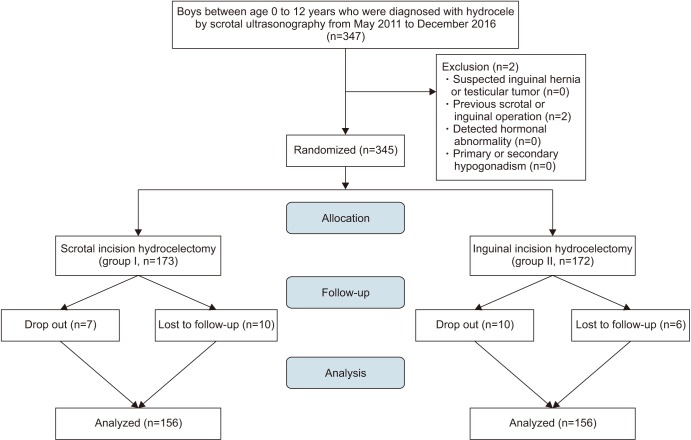Investig Clin Urol.
2018 Nov;59(6):416-421. 10.4111/icu.2018.59.6.416.
Hydrocelectomy via scrotal incision is a valuable alternative to the traditional inguinal approach for hydrocele treatment in boys
- Affiliations
-
- 1Department of Urology, Chonnam National University Medical School, Gwangju, Korea. seinsena@hanmail.net
- KMID: 2424297
- DOI: http://doi.org/10.4111/icu.2018.59.6.416
Abstract
- PURPOSE
Few studies have explored the treatment of isolated communicating hydroceles via scrotal incision. We prospectively evaluated the surgical outcomes of such treatment in boys with hydroceles compared with that using traditional, inguinal incision hydrocelectomy.
MATERIALS AND METHODS
Of 347 boys aged 0-12 years who were diagnosed as hydrocele on ultrasonography, 173 boys were assigned to the scrotal incision hydrocelectomy group (group I, n=173) and 172 boys were assigned to the traditional inguinal incision hydrocelectomy group (group II, n=172), and finally 156 boys in group I and 156 boys in group II were included in this study. Surgical outcomes, including postoperative complications and hydrocele relapse rates, were compared between groups.
RESULTS
The overall success rates were similar in both groups (group I, 96.8%; group II, 89.1%; p=0.740). The operation time and hospital stay were significantly shorter in group I (30.94±3.95 minutes and 3.94±0.30 days) than in group II (38.02±7.12 minutes and 4.24±0.99 days; p < 0.001 and p=0.009, respectively). The postoperative complication rate was lower in group I than in group II (3.2% vs. 10.9%, p=0.740).
CONCLUSIONS
Scrotal incision hydrocelectomy in boys was associated with shorter operative time and hospital stay, and a lower postoperative complication rate, than was the inguinal incision approach. The scrotal incision technique might be an easy and effective alternative treatment when used to treat hydroceles in boys as well as inguinal incision approach.
Keyword
MeSH Terms
Figure
Reference
-
1. Lasheen A. Hydrocelectomy through the inguinal approach versus scrotal approach for idiopathic hydrocele in adults. J Arab Soc Med Res. 2012; 7:68–72.2. Alp BF, Irkilata HC, Kibar Y, Zorba U, Sancaktutar AA, Kaya E, et al. Comparison of the inguinal and scrotal approaches for the treatment of communicating hydrocele in children. Kaohsiung J Med Sci. 2014; 30:200–205. PMID: 24656161.
Article3. Bevan AD. Operation for undescended testicle and congenital inguinal hernia. J Am Med Assoc. 1899; 13:773–777.
Article4. Hutcheson JC, Cooper CS, Snyder HM 3rd. The anatomical approach to inguinal orchiopexy. J Urol. 2000; 164:1702–1704. PMID: 11025753.
Article5. Soualili Z, Achouri D, Haif A, Touabti S, Yahia SA, Benmahmoud M, et al. The interscrotal approach to inguinoscrotal pathologies. Arab J Urol. 2015; 13:176–178. PMID: 26413342.
Article6. Dayanc M, Kibar Y, Irkilata HC, Demir E, Tahmaz L, Peker AF. Long-term outcome of scrotal incision orchiopexy for undescended testis. Urology. 2007; 70:786–788. discussion 788-9. PMID: 17991558.
Article7. Bassel YS, Scherz HC, Kirsch AJ. Scrotal incision orchiopexy for undescended testes with or without a patent processus vaginalis. J Urol. 2007; 177:1516–1518. PMID: 17382769.
Article8. Wilson JM, Aaronson DS, Schrader R, Baskin LS. Hydrocele in the pediatric patient: inguinal or scrotal approach? J Urol. 2008; 180(4 Suppl):1724–1727. discussion 1727-8. PMID: 18721980.
Article9. Bianchi A, Squire BR. Transscrotal orchidopexy: orchidopexy revised. Pediatric Surg Int. 1989; 4:189–192.
Article10. Koyle MA, Walsh R, Caruso A, Wilson E. Scrotal (Bianchi) approach to patent processus vaginalis in children. Tech Urol. 1999; 5:95–99. PMID: 10458663.11. Fearne Ch, Abela M, Aquilina D. Scrotal approach for inguinal hernia and hydrocele repair in boys. Eur J Pediatr Surg. 2002; 12:116–117. PMID: 12015656.
Article12. Feng S, Yang H, Li X, Yang J, Zhang J, Wang A, et al. Single scrotal incision orchiopexy versus the inguinal approach in children with palpable undescended testis: a systematic review and meta-analysis. Pediatr Surg Int. 2016; 32:989–985. PMID: 27510940.
Article13. Iyer KR, Kumar V, Huddart SN, Bianchi A. The scrotal approach. Pediatr Surg Int. 1995; 10:58–60.
Article14. Caruso AP, Walsh RA, Wolach JW, Koyle MA. Single scrotal incision orchiopexy for the palpable undescended testicle. J Urol. 2000; 164:156–158. discussion 158-9. PMID: 10840452.
Article
- Full Text Links
- Actions
-
Cited
- CITED
-
- Close
- Share
- Similar articles
-
- Hydrocele and Hydrocele of the Canal of Nuck in Children
- A Comparison between Single Scrotal Incision Orchiopexy and the Inguinal Approach in Patients with Palpable Undescended Testes Distal to the External Inguinal Ring
- A 10-Year Retrospective Study of the Operative Treatment Results of Adult Type Hydrocele
- Scrotal Hydrocele as the First Clinical Manifestation of Occult Gastric Cancer
- Calculi in Hydrocele: Incidence and Results of Infrared Spectroscopy Analysis


